A Comparison of the 2015 Team With Its 1992 Predecessor
Part Four: Examining the Starting Pitching: Middle of the Rotation

As much as “Chicks Dig The Long Ball,” the iconic tagline made famous by the Nike commercial featuring Tom Glavine, Greg Maddux, and Mark McGwire back in 1998, there is a general consensus in baseball: pitching and defence win championships. In fact, pitching is always at a premium because as the old saying goes, “you can never have too much pitching.” As we get deeper into the regular season, teams that are playing competitive baseball and have a realistic shot at the postseason frequently engage in an “arms race” in order shore up their pitching. While much of the attention is placed squarely at the front of the starting rotation with an emphasis on the ace, depth is extremely important given that baseball is a team sport and one player cannot make or break a team. Seeing that most playoff teams have an ace to anchor their starting rotation in the postseason, winning or losing often comes down to the performance of their mid-rotation guys, especially since most teams use a three-man (or at most a four-man) rotation in the postseason. Indeed, one of the reasons as to why both the 2015 Toronto Blue Jays and their 1992 predecessor were so successful—with the former claiming the American League East Division and the latter winning the World Series—was because both teams featured a very strong mid-rotation.
Number Three Starter: Marco Estrada (2015) versus Juan Guzmán (1992)
Analysis: Arguably the most reliable starting pitcher for Toronto throughout the playoffs, Marco Estrada ironically began the season in the bullpen (after eventual setup man Aaron Sanchez won the fifth starter spot out of spring training) and did not move into the starting rotation until 1 May 2015 when the Blue Jays optioned Daniel Norris to the Buffalo Bisons at AAA. In what turned out to be a career season to this point of his career, Estrada became a steady force in the starting rotation and put up impressive numbers as a starter for the entire season, establishing career-high in wins (13), earned run average (3.13), starts (28), and innings pitched (181). Along the way, he kept moving up the depth chart in the starting rotation and showed flashes of brilliance as he took a no-hitter (against the Baltimore Orioles on 19 June) and a perfect game (against the Tampa Bay Rays on 24 June) into the eighth inning in back-to-back starts. Estrada then followed up his strong regular season campaign with an arguably better postseason. First, he pitched a gem against Texas in game three of the of the American League Division Series (ALDS) on 11 October by limiting the Rangers to just one run over 61⁄3 innings on route to a five to one victory, which helped Toronto stave off elimination. He then followed up his timely performance by starting two games in the American League Championship Series (ALCS), and despite taking the loss in game one on 16 October—when the Blue Jays were shut out by Kansas City by a score of five to zero—rose to the occasion in game five on 21 October by holding the Royals to one run over 72⁄3 innings in a lopsided seven to one Toronto victory, thereby playing a pivotal role in assisting the Blue Jays to avoid elimination for the second time in the playoffs.
By contrast, even though Juan Guzmán was named the third starter behind Jack Morris and David Cone in the 1992 postseason, Guzmán was already an established front-of-the rotation starter for Toronto since he replaced injured ace Dave Stieb on the roster mid-way through the prior season. In fact, Guzmán was a dominant force for the Blue Jays during the regular reason and a main pillar in the postseason. Not only did he post an ace-like regular reason record by going 16-5 (an excellent .762 winning percentage) with a 2.64 earned run average (ERA) in twenty-eight starts over 1802⁄3 innings on route to being named an All-Star, but he was even more instrumental in helping Toronto defeat Oakland in the ALCS as he went 2-0 with an outstanding 2.08 ERA in two starts by out-dueling Athletics starters Ron Darling on 10 October 1992 and Mike Moore on 14 October in games three and five, in which the Blue Jays won 7-5 and 9-2 respectively. Guzmán was equally effective in the World Series against Atlanta. Despite recording a no decision in his only start on 20 October, he pitched eight strong innings in game three with a minuscule 1.13 ERA while yielding only one earn run. He also struck out seven Braves hitters while only walking on batter.

Verdict: Although Estrada effectively outperformed David Price—and perhaps Marcus Stroman as well—because Estrada was the de facto ace of the staff in the playoffs, we simply cannot ignore the fact that Guzmán’s numbers are better than Estrada overall, particularly when it comes to their performance in the regular season. Also, while both Estrada (1-0) and Guzmán (2-0) had a perfect record in the first round of the postseason, the latter has twice as many wins as the former, not to mention that the latter secured those wins in a more high-leverage situation (albeit there were no ALDS back in 1992). Hence, I say Guzmán gets the nod by a step.
Final Words: It is hard to argue that the 2015 edition of the Blue Jays had a better mid-rotation than its 1992 counterpart, or vice versa, given the notable contributions that both Estrada and Guzmán made to their respective teams and that they are both solid starters. However, whereas Estrada is more of an unremarkable yet reliable pitcher whose trademark is steadiness with the ability to “come up big” under desperate situations, Guzmán was close to lights out as a near-ace without the ace label (which was bestowed upon Morris). On that note, I would say that the 1992 version of the Blue Jays had an ever-so-slightly comparative advantage than its 2015 counterpart.
On deck: My evaluation of the back-end of the starting rotation for the two editions (2015 and 1992) of the Toronto Blue Jays. Be sure to tune into Part Five!
